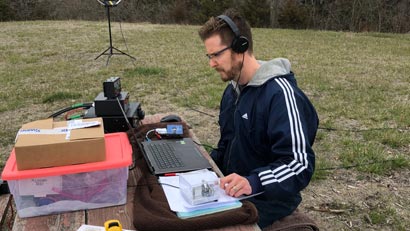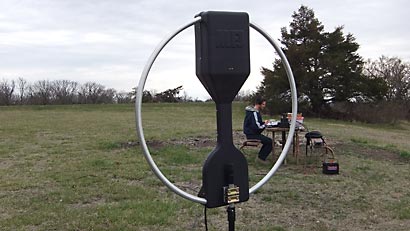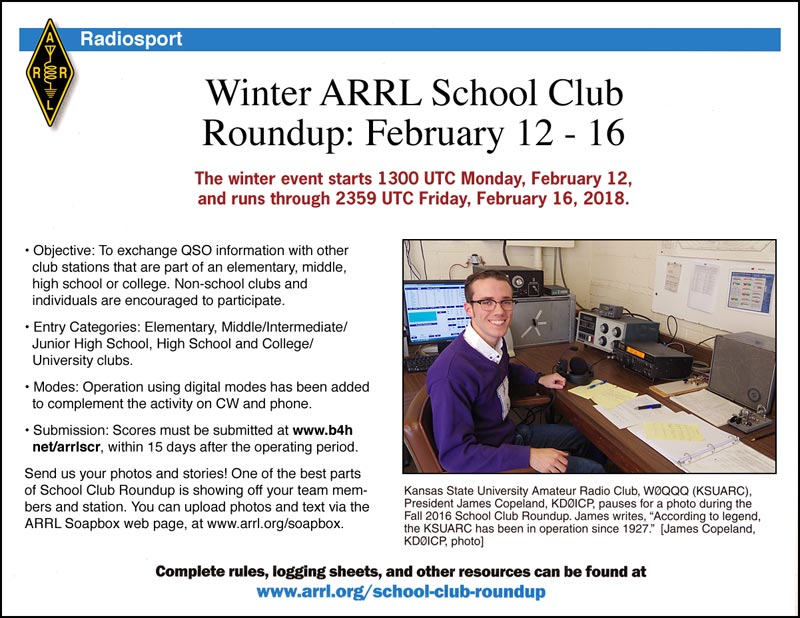

Join KSUARC (It's free!)

| Manhattan Area Repeaters |
| Callsign | Freq. & Offset | Type | Tone | Other Information |
| KSØLNK | 147.225 + | open | 114.8 | linked |
| KSØMAN | 147.255 + | open | 88.5 | autopatch, wx net |
| KSØMAN | 442.000 + | open | 88.5 | offset 447.000 |
| WØQQQ | 145.410 – | open | none | in service |
| WØQQQ | 444.175 + | open | 88.5 | in service |

OUR NEW ICOM IC-7300, OCT. 18, 2017
Visit our IC-7300 page.
Amateur Radio Club awarded $2,500 ARRL Foundation Grant
November 10, 2022
Our adviser, Vern Wirka, WØVMP, submitted the following news release for today's K-State Today. (link)
The American Radio Relay League Foundation has awarded a grant to the WØQQQ Amateur Radio Club at Kansas State University, a registered independent student organization.
The grant funds transformative projects that encourage the growth of active amateur radio operators and training opportunities, education programs for student groups and schools, and club revitalization. The ARRL Foundation, established by ARRL, The National Association for Amateur Radio®, administers the Club Grant Program.
The WØQQQ Amateur Radio Club grant is $2,500. WØQQQ was one out of 24 clubs from across the nation that were notified that they are receiving grants. The American Radio Relay League Foundation received 128 applications for this round of grants.
The foundation has long recognized that it is in the best interest of amateur radio to encourage and support amateur radio clubs. Clubs historically have recruited, licensed, and trained new radio amateurs and have provided the community setting for them to continue their education and training. The grant, to the student organization registered as Amateur Radio Club, will help provide and expand important services, through equipment upgrades and a more extensive outreach effort to involve more students, faculty, staff and community members.
The Federal Communications Commission-licensed club station operates under the callsign WØQQQ. The station is on the fourth floor of Seaton Hall. For more information about WØQQQ, contact club adviser Vern Wirka, at
vwirka@k-state.edu

|
Message from the Secretary
David Yoder, KAØJPM
April 22, 2020
Here's a shout out for the best instructional video I've ever seen. Our ICOM IC-7300 has a spectrum scope and waterfall display that I barely understood, until I found a video by Kevin Loughin, KB9RLW, Spectrum Scopes and Identifying Signals Visually. It runs 27 minutes. Kevin demonstrates how it displays various signals and modes. I honestly thought the display was mostly a silly gimmick, until I saw him put it to use.
|

Many thanks and 73 to our excellent KSUARC adviser from 1996 to 2011, Dr. Bill Kuhn, KO4MH.
Vern Wirka Reflects on Radio, Teaching Career
Manhattan Mercury
December 2, 2018

KSUARC's adviser, Vern Wirka, WØVMP, is retiring from K-State's A. Q. Miller School of Journalism and Mass Communications this month. KSUARC members are pleased to report that as an emeritus professor, Vern can and will continue as our adviser! He has made outstanding contributions to our club. An Extra class licensee and experienced broadcaster, he has contributed his technical knowledge and skills constantly during his years at K-State. He has done extensive work on our antenna systems, equipment and repeaters, as just a few examples. He guided us through the transition to the university's new stance on student organizations. He's also been very welcoming and helpful to new student members.
Today, WØVMP was featured in the Manhattan Mercury. Be sure to have a look!
|
Message from the President
WØQQQ Third Nationally in the ARRL's Fall School Roundup
James Copeland, KDØICP
November 9, 2018
I'm proud to announce that WØQQQ placed THIRD this year in the college/university category with 49,560 points! Thank you to all who participated in making this contest a reality. We've already been busy with responding to the flood of QSLs in the mailbox. You can check out the score breakdown here. Check out our soapbox comment, and some pictures I posted to the ARRL page.
Again, thank you to everyone who participated in our most successful contest in recent club history!
Edit from KAØJPM: James submitted the good news about KSUARC's 3rd-place finish to the Midwest Division, and our Midwest Director (and former KSUARC member, Rod Blocksome, KØDAS), added it to the December 2018 Midwest Division Newsletter! It's available as as PDF in this link, as only the latest edition seems to be available on the Internet.
|
Message from the President
WØQQQ Antenna Updates
James Copeland, KDØICP
July 30, 2018
It was a productive weekend at WØQQQ. Alumnus Bob Hitt generously donated his climbing skills to help knock out several projects. First of all, the 2m/70cm repeater antenna is now about 15 feet lower than it was, on a new bracket. It is believed that a lightning storm took out our Diamond antenna a couple weeks ago. Bob removed the Diamond, and it did indeed test bad. The coax feeding it was still in good shape. We will have to decide as a club on replacement options - either buying a new dual-band antenna or two separate antennas.
Second, the new CW dipoles for 17, 20 and 30 are now real slopers. All three have been run through pulleys on the tower.
Third, the MFJ vertical that Dr. Kuhn donated has been mounted on the picnic table. Anyone who is interested in a tuning project is welcome to have at it!
Fourth, our 2-meter transceiver in the club has been hooked up to a new power supply (the old one was too small for full output), and is currently hooked up to the large 2-meter beam that has been mounted to the short piece of tower on the west fence. We are currently looking for either a dual-band or just a single-band base station 70 cm rig that can be used to monitor 444.175. Anyone got one lying around?
Thanks to everyone who came out Sunday, and if you haven't been to the shack recently, go check it out! More to come as we get closer to the start of the semester, but in the meantime, enjoy your summer!
|
Message from the Adviser
Antenna Updates
Vern Wirka, WØVMP
April 30, 2018
An MFJ antenna and transceiver selector has been installed in the rack on the operating desk. The left switch allows the selection of either the Icom IC-736, the Icom IC-7300 or a third position marked "Open." The "Open" position goes to a coax cable that can be used for a third transceiver, or an easy way to connect an antenna analyzer. The right switch allows for the selection of any of the antennas which are now part of the WØQQQ roof-top antenna farm; the dipole fed with balanced line, TH6 Hy-Gain beam, 20-meter CW dipole, 17-meter dipole and a 30-meter dipole. The right switch also has a position for the dummy load.
It is recommended that when operation is completed, the left switch should be placed in the "Open" position (if no transceiver is connected), or one of the unused positions. Select the dummy load on the right switch, and leave it there. By selecting the dummy load position all of the antennas are grounded.
The additional dipoles will enhance our digital capabilities, as all of them are resonant in the part of the bands where the digital modes are used.
There are more improvements on the schedule; stay tuned.
73,
Vern Wirka
WØVMP
|
Club Member Kurt Zoglmann, ADØWE, Describes His First CW Contact
April 22, 2018
I hope you don't mind me sharing a personal success. I am excited to have made my very first Morse code contact this weekend! And portable at that! I forgot the microphone at home. I kid you not. It helped me overcome my hesitation to get on the air after months of practice.
We went out to Randolph State Park. I appreciated that Jason came with me. He had fun painting with watercolors and listening to podcasts while I played amateur radio. My uncle Greg, NØZHE, listened intently 300 miles away to the South and encouraged me via text message to keep trying after a first failed attempt. I welcomed the moral support!
Unfavorable band conditions did not deter me. I called CQ for about 5 to 10 minutes on 14.035 Mhz using 75 watts. Then VE7UBC, the University of British Columbia Amateur Radio Society, came back to me. They are in Vancouver Canada! We had a short QSO. I gave my name, mentioned that this was my first CW contact, and provided the weather conditions at my location. Dan gave his location, radio, antenna, and indicated that my first QSO was going much better than his first one from years ago. That made me feel better.
What I wasn't anticipating was how nervous I became when someone came back to me. I was able to copy just fine, but my nervousness caused me to make a lot of mistakes in sending. I especially valued Dan's patience! He mentioned that QSB was making it extra hard for him to copy me. His signal was 559 with little-to-no QSB. I would have loved to rag chew, but I did not want to test his endurance. hi hi. I thanked him and was left smiling ear-to-ear.
As pictured, you can see that I am transmitting with my ICOM 7300 radio into an MFJ magnetic loop antenna. To the left of me, I am sending code with the Bencher BY-2 paddle and using the Begli CW Machine as a keyer. The Bencher paddle isn't the most portable paddle, but it worked splendidly. I was happy to have brought the battery boost. It enabled me to send more than 20 watts using the deep cycle, lead-acid battery.
I am hoping to participate in POTA (Parks On The Air) this spring and summer. I am looking forward to many more Morse code contacts! I am also looking forward to my Lithium-Iron-Phosphate battery coming in. It will be lighter and won't sag under high-amperage draws.
webmaster's note: Thanks to Kurt for permission to add the story of his DXpedition to our web page.


(click photos for originals)
|
Message from the Secretary-Treasurer
David Yoder, KAØJPM
March 14, 2018
As webmaster, I'm taking the liberty of announcing a feature article in the March 13 Collegian on our outstanding president, James Copeland, KDØICP. James, a senior in broadcasting, is also the program director for 91.9 KSDB. He takes his responsibilities very seriously, and brings great energy to his work. I recommend having a look at this well-done profile, for a better appreciation of his leadership and hard work. (I didn't ask for permission to compliment him here!)

Collegian photo
|
Message from the President
James Copeland, KDØICP
February 16, 2018
In typical collegiate fashion, there was a flurry of activity during the last hour of the February 2018 school club roundup. KSUARC operators were able to finish the contest by contacting several other collegiate clubs on 40 meters. The old KSUARC record, set in October 2016 at 17,812 points, was surpassed by the new total of 22,627. A further breakdown follows:
• Total Contacts: 179
• Total States and Provinces Worked = 32
• Total Countries Worked = 1
• Total Number of Clubs Worked: 1
• Total Number of Schools Worked: 17
There were many highlights of the event, but one of particular interest was talking to N3FJP, the creator of the software used to log the contest. Thanks to everyone who helped make this year's roundup a reality. Special thanks to Vern, WØVMP, for all his time put in and for making several CW contacts.
|
|
Kurt Zoglmann, ADØWE, Continues His Amateur Radio Adventures
KSUARC member (and past president) Kurt Zoglmann has posted a tremendous documentation of assembling a 20m QCX transceiver kit. He describes the entire process, and has photos, too. His first contact was with a station in California, on about 1 watt! You can find his story on QRZ.COM. Also, you can read other outstanding write-ups on learning CW, and his early QSOs.

Kurt has written about a number of recent projects and activities since taking on the kit-building project. They're all described in detail on his QRZ page, linked above, and include:
- 2019 goal of Worked All States on CW
- scanning a full-length book to use for CW practice at various speeds
- participation in the CQ Worldwide WPX contest at WØQQQ
- reviewing the Morserino-32 practice trainer / keyer / CW decoder
UPDATE: We may have found Kurt's ultimate project so far, the Morse Code Ninja! Here's an excerpt of Kurt's goals - in his words - in creating this online course, which is now complete:
"The format of my Morse code course provides continuous and immediate feedback. For each character(s), word, or callsign sent in Morse code, it is then spoken after a one-second pause. This format accelerates the learning process, and reduces frustration. And it has proved to be popular in my more advanced practice videos.
The course is structured so that it is incrementally more difficult, and encourages head-copying from the start! There are 259 lessons. I introduce the characters in the same order as the Level 1 CW Academy class, so the course can be used as a supplement or stand on its own. If you have any feedback, please let me know! I'm open to improving the course. (Note that you will be able to make it through the first few lessons in no time flat. Just listen to the introduction videos until you get the character down. Then in the 1-second pause in the other videos, say out loud whatever you are able to copy. Then move on to the next lesson as soon as you reach 70 to 90% accuracy.)"
KAØJPM's comments: I really like the feedback after a word is sent, and it's sent a second time just after you hear the word spoken. Also, I think it's good that the characters are sent fast, so you need to learn and react to the sound of the character, rather than trying to analyze it or translate it. That makes a huge difference when you try to get above 10 words per minute. You'd just as well learn from day one to have your hand reflexively write the character, rather than using your conscious mind to think about what you just heard. When I took my 20 WPM code test, I had virtually no idea what I had written over the five minutes, until I looked at it after the test. I passed!
|
|




















